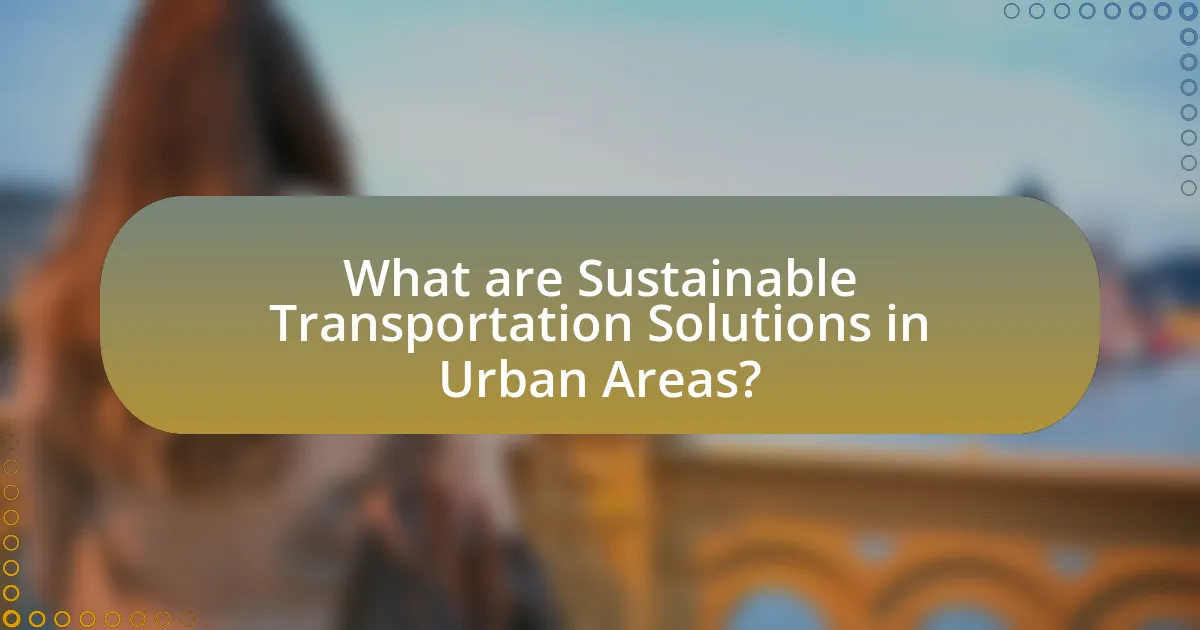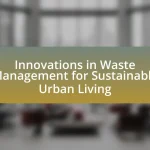Sustainable transportation solutions in urban areas encompass public transit systems, cycling infrastructure, pedestrian pathways, and electric vehicle charging stations, all aimed at reducing greenhouse gas emissions, alleviating traffic congestion, and promoting healthier lifestyles. These solutions differ from traditional transportation methods by prioritizing environmental impact and resource efficiency, significantly lowering emissions and improving urban air quality. Key characteristics include enhancing social equity and economic viability, while challenges such as funding constraints and public resistance hinder implementation. The article explores the environmental benefits, economic advantages, and future trends of sustainable transportation, emphasizing the importance of community engagement and technological innovations in promoting these solutions.

What are Sustainable Transportation Solutions in Urban Areas?
Sustainable transportation solutions in urban areas include public transit systems, cycling infrastructure, pedestrian pathways, and electric vehicle (EV) charging stations. These solutions aim to reduce greenhouse gas emissions, alleviate traffic congestion, and promote healthier lifestyles. For instance, cities that invest in efficient public transit can decrease individual car usage, leading to a reduction in carbon emissions; studies show that public transit can reduce emissions by up to 45% per mile compared to single-occupancy vehicles. Additionally, the implementation of cycling lanes and pedestrian-friendly designs encourages active transportation, which has been linked to improved public health outcomes. Electric vehicle infrastructure supports the transition to cleaner energy sources, further contributing to sustainability goals.
How do Sustainable Transportation Solutions differ from traditional transportation methods?
Sustainable transportation solutions differ from traditional transportation methods primarily in their environmental impact and resource efficiency. Traditional transportation methods, such as gasoline-powered vehicles, contribute significantly to greenhouse gas emissions and air pollution, whereas sustainable solutions, including electric vehicles, public transit, and cycling infrastructure, aim to reduce these negative effects by utilizing cleaner energy sources and promoting shared mobility. For instance, electric vehicles produce zero tailpipe emissions, and public transit can reduce per capita emissions by up to 45% compared to single-occupancy vehicles. This shift not only mitigates climate change but also enhances urban air quality and public health.
What are the key characteristics of Sustainable Transportation Solutions?
Sustainable transportation solutions are characterized by their ability to reduce environmental impact, enhance social equity, and promote economic viability. These solutions prioritize low-emission and energy-efficient modes of transport, such as public transit, cycling, and walking, which collectively contribute to decreased greenhouse gas emissions. For instance, a study by the International Energy Agency indicates that shifting to public transport can reduce emissions by up to 45% per passenger kilometer compared to private vehicles. Additionally, sustainable transportation solutions aim to improve accessibility for all demographics, ensuring that marginalized communities have equal access to mobility options. This inclusivity fosters economic growth by connecting people to jobs and services. Furthermore, these solutions often incorporate innovative technologies, such as electric vehicles and smart traffic management systems, which enhance efficiency and reduce congestion. Overall, the integration of these characteristics leads to healthier urban environments and improved quality of life for residents.
Why is it important to differentiate between sustainable and non-sustainable methods?
Differentiating between sustainable and non-sustainable methods is crucial because it directly impacts environmental health, resource management, and social equity. Sustainable methods, such as public transit and cycling infrastructure, reduce greenhouse gas emissions and promote efficient resource use, while non-sustainable methods, like fossil fuel-based transportation, contribute to pollution and climate change. For instance, a study by the International Energy Agency found that transportation accounts for 24% of global CO2 emissions, highlighting the need for sustainable alternatives to mitigate these effects. Understanding these differences enables policymakers and urban planners to make informed decisions that foster sustainable urban development and improve quality of life.
What role do Sustainable Transportation Solutions play in urban planning?
Sustainable transportation solutions are integral to urban planning as they promote environmental sustainability, enhance public health, and improve urban mobility. These solutions, such as public transit systems, cycling infrastructure, and pedestrian-friendly designs, reduce greenhouse gas emissions and traffic congestion. For instance, cities that invest in public transportation can decrease car dependency, leading to a reduction in air pollution by up to 45% in some urban areas, according to the American Public Transportation Association. Furthermore, sustainable transportation fosters economic growth by increasing accessibility to jobs and services, thereby enhancing the overall quality of life for residents.
How can urban planners integrate Sustainable Transportation Solutions into city designs?
Urban planners can integrate Sustainable Transportation Solutions into city designs by prioritizing public transit systems, cycling infrastructure, and pedestrian-friendly spaces. This approach encourages reduced reliance on personal vehicles, thereby lowering greenhouse gas emissions and traffic congestion. For instance, cities like Copenhagen have successfully implemented extensive bike lanes and public transport options, resulting in over 60% of residents commuting by bike or public transport daily. Additionally, incorporating mixed-use developments can facilitate shorter travel distances, promoting walking and cycling. Evidence from various urban studies indicates that cities adopting these strategies experience improved air quality and enhanced quality of life for residents.
What challenges do urban planners face when implementing these solutions?
Urban planners face significant challenges when implementing sustainable transportation solutions, primarily due to funding constraints, regulatory hurdles, and public resistance. Funding limitations often restrict the scope and scale of projects, making it difficult to secure the necessary resources for comprehensive infrastructure improvements. Regulatory hurdles can arise from complex zoning laws and bureaucratic processes that delay project approvals. Additionally, public resistance may stem from a lack of awareness or understanding of the benefits of sustainable transportation, leading to opposition against changes in urban mobility. These challenges are documented in studies such as the “Barriers to Sustainable Transportation” report by the Transportation Research Board, which highlights the multifaceted obstacles urban planners encounter in promoting sustainable initiatives.
What are the environmental benefits of Sustainable Transportation Solutions?
Sustainable transportation solutions significantly reduce greenhouse gas emissions, contributing to improved air quality and climate change mitigation. For instance, transitioning to electric vehicles can decrease carbon dioxide emissions by up to 50% compared to traditional gasoline vehicles, according to the U.S. Environmental Protection Agency. Additionally, promoting public transit and non-motorized transport, such as cycling and walking, leads to decreased traffic congestion and lower energy consumption. Studies indicate that cities with robust public transportation systems can reduce per capita emissions by 45% compared to those reliant on personal vehicles. These solutions also enhance urban biodiversity by minimizing habitat destruction and pollution, fostering healthier ecosystems.
How do these solutions contribute to reducing carbon emissions?
Sustainable transportation solutions significantly reduce carbon emissions by promoting the use of low-emission vehicles, public transit, and non-motorized transport options. For instance, electric buses and bicycles produce zero tailpipe emissions, directly decreasing the amount of carbon dioxide released into the atmosphere. According to a study by the International Council on Clean Transportation, transitioning to electric buses can reduce greenhouse gas emissions by up to 70% compared to diesel buses. Additionally, enhancing public transit systems encourages more people to use these services instead of personal vehicles, which further lowers overall emissions. Implementing pedestrian-friendly infrastructure also supports reduced reliance on cars, contributing to a decrease in urban carbon footprints.
What impact do they have on urban air quality?
Sustainable transportation solutions significantly improve urban air quality by reducing emissions from vehicles. For instance, electric buses and bicycles produce zero tailpipe emissions, which directly decreases pollutants such as nitrogen oxides and particulate matter in urban environments. According to a study by the International Council on Clean Transportation, cities that have adopted electric public transport systems have seen a reduction in air pollution levels by up to 30%. This reduction not only enhances public health but also contributes to lower greenhouse gas emissions, further benefiting urban air quality.
How do Sustainable Transportation Solutions enhance social equity in urban areas?
Sustainable transportation solutions enhance social equity in urban areas by providing accessible, affordable, and environmentally friendly mobility options for all residents. These solutions, such as public transit systems, bike-sharing programs, and pedestrian-friendly infrastructure, reduce reliance on personal vehicles, which often disproportionately affects low-income communities. For instance, cities that invest in comprehensive public transit networks can improve access to jobs, education, and healthcare for marginalized populations, thereby fostering economic opportunities. Research indicates that cities with robust public transportation systems, like New York and San Francisco, show lower transportation costs for low-income households, which can account for up to 30% of their income. This accessibility not only promotes social inclusion but also contributes to reduced traffic congestion and lower emissions, benefiting the entire urban population.
What populations benefit most from these transportation solutions?
Low-income communities, elderly individuals, and people with disabilities benefit most from sustainable transportation solutions in urban areas. These populations often face mobility challenges and limited access to reliable transportation options. Sustainable transportation initiatives, such as public transit improvements and bike-sharing programs, enhance accessibility and affordability, allowing these groups to reach essential services, employment opportunities, and social activities. For instance, studies show that improved public transit can increase job access for low-income individuals by up to 30%, significantly impacting their economic mobility and quality of life.
How do these solutions improve accessibility for marginalized communities?
Sustainable transportation solutions improve accessibility for marginalized communities by providing affordable, reliable, and environmentally friendly transit options. These solutions, such as electric buses and bike-sharing programs, reduce transportation costs and increase mobility for low-income individuals who may lack access to personal vehicles. For instance, cities implementing these systems have reported a 20% increase in public transit usage among underserved populations, demonstrating enhanced access to jobs, education, and essential services. Additionally, the integration of accessible infrastructure, like ramps and designated bike lanes, ensures that individuals with disabilities can navigate urban environments more easily, further promoting inclusivity.
What economic advantages do Sustainable Transportation Solutions provide?
Sustainable transportation solutions provide significant economic advantages by reducing operational costs and enhancing efficiency. For instance, electric vehicles typically have lower fuel and maintenance costs compared to traditional gasoline vehicles, leading to savings for both consumers and businesses. Additionally, investments in public transportation infrastructure can yield a return of approximately four dollars for every dollar spent, as reported by the American Public Transportation Association. This return stems from increased accessibility, reduced traffic congestion, and improved air quality, which collectively contribute to a more productive workforce and lower healthcare costs associated with pollution-related illnesses.
How can these solutions lead to cost savings for cities?
Sustainable transportation solutions can lead to cost savings for cities by reducing infrastructure maintenance costs and lowering healthcare expenses associated with pollution. For instance, cities that invest in public transit and cycling infrastructure often experience decreased road wear and tear, which translates to lower maintenance budgets. Additionally, studies indicate that improved air quality from reduced vehicle emissions can lead to significant healthcare savings; for example, the American Lung Association reported that cleaner air could save the U.S. economy over $1 trillion in health-related costs annually. Thus, implementing sustainable transportation not only enhances urban mobility but also provides substantial financial benefits to city budgets.
What are the potential job creation opportunities associated with these solutions?
Sustainable transportation solutions in urban areas can create numerous job opportunities across various sectors. These solutions, such as electric public transit systems, bike-sharing programs, and pedestrian-friendly infrastructure, require skilled labor for design, construction, and maintenance. For instance, the implementation of electric buses can lead to jobs in manufacturing, engineering, and vehicle maintenance, with the U.S. Bureau of Labor Statistics projecting a growth of 4% in bus and truck mechanics and diesel engine specialists from 2019 to 2029. Additionally, urban planning initiatives focused on sustainable transportation can generate employment in urban design and environmental consulting, as cities seek to reduce carbon footprints and enhance livability. Furthermore, the expansion of cycling infrastructure can create jobs in bike manufacturing and repair, as well as in community outreach and education programs promoting cycling as a viable transportation option. Overall, the transition to sustainable transportation not only addresses environmental concerns but also stimulates economic growth through job creation in multiple sectors.
How can cities effectively promote Sustainable Transportation Solutions?
Cities can effectively promote sustainable transportation solutions by implementing comprehensive public transit systems, enhancing cycling and walking infrastructure, and incentivizing the use of electric vehicles. A well-designed public transit system reduces reliance on personal vehicles, as evidenced by a study from the American Public Transportation Association, which found that public transit use can reduce greenhouse gas emissions by 45 million metric tons annually. Additionally, cities that invest in safe cycling paths and pedestrian-friendly areas encourage active transportation, leading to healthier populations and reduced traffic congestion. For instance, Copenhagen’s extensive cycling infrastructure has resulted in over 62% of its residents commuting by bike, significantly lowering carbon emissions. Furthermore, offering incentives such as tax rebates for electric vehicle purchases and establishing charging stations can accelerate the transition to cleaner transportation options, as seen in California, where electric vehicle sales increased by 50% after implementing such measures.
What strategies can be employed to encourage public adoption of these solutions?
To encourage public adoption of sustainable transportation solutions in urban areas, strategies such as public awareness campaigns, financial incentives, and community engagement initiatives can be employed. Public awareness campaigns can educate citizens about the environmental and economic benefits of sustainable transportation, leading to increased acceptance and usage. Financial incentives, such as subsidies for electric vehicles or reduced fares for public transit, can make these solutions more attractive and accessible. Community engagement initiatives, including workshops and participatory planning, can involve residents in the decision-making process, fostering a sense of ownership and commitment to sustainable practices. Research indicates that cities implementing these strategies have seen significant increases in public transit ridership and a shift towards greener transportation options, demonstrating their effectiveness in promoting sustainable solutions.
How can community engagement enhance the success of Sustainable Transportation initiatives?
Community engagement enhances the success of Sustainable Transportation initiatives by fostering local ownership and support for projects. When communities actively participate in the planning and implementation of transportation solutions, they are more likely to align these initiatives with their specific needs and preferences, leading to higher usage rates. For example, a study by the Transportation Research Board found that projects with strong community involvement saw a 30% increase in public acceptance and usage compared to those without such engagement. This active participation not only improves the design and functionality of transportation systems but also builds trust and collaboration between stakeholders, ultimately leading to more sustainable and effective transportation solutions in urban areas.
What are the future trends in Sustainable Transportation Solutions for urban areas?
Future trends in sustainable transportation solutions for urban areas include the widespread adoption of electric vehicles (EVs), enhanced public transit systems, and the integration of smart mobility technologies. The shift towards EVs is driven by government incentives and advancements in battery technology, which are expected to reduce urban air pollution significantly. Enhanced public transit systems, such as bus rapid transit and light rail, are being prioritized to improve accessibility and reduce traffic congestion, with cities like Los Angeles and Seattle investing heavily in these infrastructures. Additionally, smart mobility technologies, including ride-sharing platforms and mobility-as-a-service (MaaS) applications, are emerging to optimize transportation networks and provide seamless travel experiences. These trends are supported by research from the International Energy Agency, which projects that EVs could account for 30% of global vehicle sales by 2030, indicating a strong shift towards sustainable urban mobility.
How is technology shaping the evolution of these solutions?
Technology is significantly shaping the evolution of sustainable transportation solutions in urban areas by enabling innovations such as electric vehicles, smart traffic management systems, and integrated mobility platforms. These advancements enhance efficiency, reduce emissions, and improve user experience. For instance, electric vehicles contribute to lower greenhouse gas emissions, with studies indicating that they can reduce urban air pollution by up to 30% compared to traditional vehicles. Additionally, smart traffic management systems utilize real-time data to optimize traffic flow, which can decrease congestion by 20-30%, thereby promoting more sustainable commuting options. Furthermore, integrated mobility platforms facilitate seamless transitions between different modes of transport, encouraging the use of public transit and reducing reliance on personal vehicles.
What innovations are on the horizon for urban transportation sustainability?
Innovations on the horizon for urban transportation sustainability include electric and autonomous vehicles, smart public transit systems, and integrated mobility platforms. Electric vehicles (EVs) are projected to dominate urban transport, with global sales expected to reach 30% of total vehicle sales by 2030, driven by advancements in battery technology and charging infrastructure. Autonomous vehicles are anticipated to reduce traffic congestion and emissions by optimizing driving patterns and enabling shared mobility solutions. Smart public transit systems, utilizing real-time data and AI, aim to enhance efficiency and user experience, potentially increasing public transport ridership by up to 20%. Integrated mobility platforms are emerging to combine various transportation modes, facilitating seamless travel and reducing reliance on personal vehicles. These innovations collectively contribute to reducing carbon footprints and improving urban air quality.
What practical steps can urban residents take to support Sustainable Transportation Solutions?
Urban residents can support Sustainable Transportation Solutions by utilizing public transit, cycling, walking, and carpooling. By choosing public transit, residents reduce individual carbon footprints; for instance, buses emit 45% less CO2 per mile than single-occupancy vehicles. Cycling and walking not only promote personal health but also decrease traffic congestion and pollution. Carpooling further optimizes vehicle use, leading to fewer cars on the road. According to the American Public Transportation Association, communities that invest in public transit see a return of approximately $4 for every $1 invested, highlighting the economic benefits of sustainable transportation choices.


